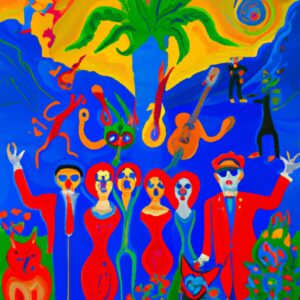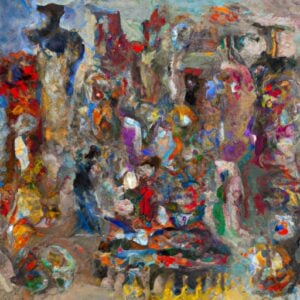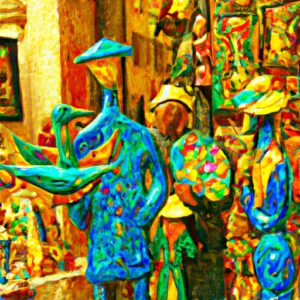Italian is the official language of Italy, a country known for its rich history, culture, and contributions to art, music, and cuisine. Understanding the language spoken in Italy is essential for communication, cultural immersion, and appreciating the country’s heritage. In this article, we will explore the Italian language, its history, characteristics, and variations, as well as its importance in Italy and around the world. We will also discuss the benefits of learning Italian and provide resources and methods for language acquisition. Whether you’re planning a trip to Italy or interested in expanding your linguistic skills, discovering the Italian language opens doors to a world of cultural treasures and connections.

What Language Do Italians Speak?
Italians primarily speak the Italian language.
The Italian language, also known as Italiano, is a Romance language that originated in Italy. It is the official language of Italy, San Marino, Switzerland (Ticino and parts of Graubünden), and Vatican City. It is one of the official languages of the European Union.
Italian is spoken by approximately 85 million people worldwide, with the majority residing in Italy. It is also spoken by Italian communities and descendants in other countries, making it one of the most widely spoken languages globally.
The Italian language has a rich history and is known for its melodic sound and expressive nature. It has influenced various other Romance languages and has contributed significantly to literature, art, music, and culture.
Knowing the Italian language can enhance communication and cultural understanding when visiting or interacting with Italian-speaking regions.
The Official Language of Italy
The official language of Italy is Italian.
Italian, a Romance language, is spoken by the majority of the population in Italy. It is also one of the official languages of Switzerland, San Marino, Vatican City, and Istria County in Croatia. Italian is derived from Latin and has its roots in the Tuscan dialect.
While Italian is the dominant language, there are also several regional languages and dialects spoken in different parts of Italy. These include Sicilian, Neapolitan, Sardinian, Venetian, and many others. These regional languages often have their unique characteristics and influences.
Italian is widely taught in schools throughout Italy and is the primary language used in government, education, media, and business. It is a language rich in history and culture, playing a significant role in the arts, literature, and music.
So, when it comes to the language spoken in Italy, the answer is unequivocally Italian.
Is Italian the Only Language Spoken in Italy?
Italian is not the only language spoken in Italy. While Italian is the official language of the country, there are also numerous regional languages and dialects spoken throughout Italy. These regional languages vary in pronunciation, vocabulary, and grammar, reflecting the diverse cultural and historical influences in different regions. Some of the regional languages in Italy include Sicilian, Venetian, Neapolitan, and Sardinian. These languages have their own unique characteristics and are often spoken alongside or even instead of Italian in their respective regions.
Is Italian the Only Language Spoken in Italy?
It is estimated that around 34% of Italians speak a regional language or dialect as their first language, particularly in rural areas. The use of regional languages is deeply rooted in local traditions, family upbringing, and cultural identity. While Italian remains the language of communication and education, regional languages have continued to play a significant role in preserving local heritage and fostering a sense of regional pride.
The recognition and preservation of regional languages in Italy have been a topic of debate and active efforts from various linguistic organizations and cultural associations. These initiatives aim to protect and promote linguistic diversity within the country. It is essential to acknowledge and respect the presence of these regional languages alongside Italian in order to fully appreciate the linguistic richness of Italy.
Fun fact: Italy has the highest number of UNESCO World Heritage Sites in the world.
The Italian Language
Italy, the birthplace of art, fashion, and mouthwatering cuisine, isn’t just famous for these things—it’s also renowned for its language. In this section, we’ll dive into the captivating world of the Italian language. From its fascinating history and origins to its unique characteristics and features, we’ll uncover the linguistic wonders that make Italian a cherished and melodious tongue. Prepare to be enchanted by the magic of Italian as we unravel its secrets in the next few paragraphs.
History and Origins of the Italian Language
The history and origins of the Italian language can be traced back to the Latin language spoken during the Roman Empire. The Latin language, which was the official language of the Roman Empire, had a significant influence on the development of Italian. Over time, Latin evolved and transformed, giving birth to what is now known as Italian.
During the Middle Ages, regional variations of Latin started to emerge in different parts of Italy, thus leading to the emergence of distinct regional languages. These variations were influenced by local dialects and cultural differences. As a result, the Italian language began to diverge into various regional languages.
In the 13th and 14th centuries, the renowned Italian poet Dante Alighieri played a vital role in shaping the modern Italian language. Dante’s famous work, “The Divine Comedy,” was written in a form of Italian that closely resembled the vernacular of Florence, his hometown. This particular form of Italian became the foundation upon which the standardized Italian language was built.
With the arrival of the Italian Renaissance in the 15th century, the Tuscan dialect, similar to Dante’s vernacular, gained prominence and became the language of literature and education. Over time, it gradually gained acceptance and was eventually adopted as the official language of Italy in the 19th century.
Today, Italian, with approximately 85 million speakers worldwide, stands as the official language of Italy and is also recognized as a minority language in some neighboring countries. The history and origins of the Italian language reflect its rich heritage and cultural significance.
Characteristics and Features of Italian
| Characteristics | Features |
|---|---|
| Phonetics | Italian has a consistent pronunciation system where each letter or combination of letters represents a specific sound. There are 21 consonants and 7 vowels. |
| Grammar | Italian grammar is characterized by its gendered nouns (masculine and feminine), articles that agree in gender and number, verb conjugations based on tense, mood, and subject, and a complex system of pronouns. |
| Vocabulary | Italian vocabulary is derived from Latin, and it shares many similarities with other Romance languages. It also has a rich collection of words and expressions that are unique to Italian culture and history. |
| Verb Tenses | Italian has a comprehensive system of verb tenses, including present, past, future, conditional, and subjunctive forms. Verbs are conjugated based on the subject and can convey precise actions and states. |
| Phrases and Idioms | Italian is known for its beautiful phrases and idiomatic expressions that add color and richness to the language. These phrases often reflect the passion and poetry of Italian culture. |
| Regional Variations | Italian exhibits regional variations in pronunciation, vocabulary, and grammar. Certain regions have their own dialects, such as Venetian, Neapolitan, and Sicilian, which can differ significantly from Standard Italian. |
| Musicality | Italian is considered a musical language due to its natural rhythm and melody. The language flows smoothly and is often associated with opera, classical music, and poetry. |
These characteristics and features make Italian a unique and expressive language, cherished by both native speakers and language learners alike. Whether you’re captivated by its phonetics, fascinated by its grammar, or drawn to its rich vocabulary, studying Italian can be a rewarding and enriching experience.
Variations and Dialects of Italian
Italian language is a rich tapestry of variations and dialects that reflect the diverse cultural landscape of Italy. In this section, we’ll dive into the intriguing world of regional dialects across Italy, exploring their distinct flavors and influences. We’ll also take a closer look at the fascinating interplay between the standard Italian language and these regional dialects, uncovering the unique characteristics that set them apart. Get ready to embark on a linguistic journey through Italy like no other!
Regional Dialects in Italy
Regional dialects in Italy contribute to the linguistic diversity of the country. These dialects have their own distinct characteristics and variations in different regions. Italy boasts around 34 regional dialects, including well-known ones like Sicilian, Neapolitan, Venetian, and Milanese. Historical, cultural, and geographical factors have shaped these dialects, which have also been influenced by various languages over time.
Regional dialects in Italy can differ significantly from Standard Italian in terms of pronunciation, vocabulary, and grammar. This often makes them unintelligible to speakers of other dialects or even Standard Italian. While Standard Italian is predominantly used in formal and official settings, education, and media, regional dialects are more prevalent in informal and everyday conversations.
If you’re planning to travel to different regions of Italy, learning some basic phrases or expressions in the local dialect can be beneficial. It not only enhances your interaction with locals but also shows an appreciation for their cultural heritage.
Standard Italian vs. Regional Dialects
When discussing the Italian language, it is important to understand the differences between Standard Italian and Regional Dialects. Here are some key points to consider:
- Standard Italian: This is the official language of Italy and is based on the Tuscan dialect. It is the variety of Italian that is taught in schools and used in formal settings. Standard Italian is used in government, media, and business interactions throughout the country. It serves as a unifying language for all Italians, regardless of their regional dialects.
- Regional Dialects: Italy is known for its rich linguistic diversity, with various regions having their own distinct dialects. These dialects evolved from Vulgar Latin and have unique grammar, vocabulary, and pronunciation. Some popular Regional Dialects include Sicilian, Neapolitan, and Venetian. Regional Dialects are commonly spoken in informal, everyday situations among local communities.
- Dialect Variation: The variations between Standard Italian and Regional Dialects are extensive. While Standard Italian follows a standardized grammar and vocabulary, Regional Dialects may have different rules and vocabulary, making them somewhat distinct from one another. Regional Dialects have a strong influence on local culture and heritage, reflecting the history and traditions of each region.
- Language Choice: Italians are generally proficient in both Standard Italian and their Regional Dialects. The choice of which language to use depends on the context and the individuals involved in the conversation. Standard Italian is often used in formal situations, while Regional Dialects are preferred in informal settings among friends, family, and within local communities.
Despite the variations between Standard Italian and Regional Dialects, both play significant roles in Italian culture and identity. The preservation and promotion of Regional Dialects are essential for maintaining cultural diversity within Italy. At the same time, Standard Italian helps to foster national unity and facilitate communication between Italians from different regions.
Understanding the distinction between Standard Italian and Regional Dialects provides a deeper appreciation for the linguistic richness of Italy, showcasing the country’s historical and cultural complexities.
The Importance of Italian Language in Italy
When it comes to the importance of the Italian language in Italy, there are two key aspects to consider. We’ll delve into how Italian serves as a cultural identity, shaping the nation’s heritage and shared experiences. We’ll explore the efforts in language preservation and promotion within Italy, highlighting the significance of safeguarding and celebrating this beautiful language. So, let’s journey into the world of Italian and uncover the rich layers of its significance to the people of Italy!
Italian as a Cultural Identity
- Italian language plays a significant role in shaping the cultural identity of Italy as a nation.
- The language reflects the rich history and heritage of the Italian people, contributing to their cultural identity.
- Italian is deeply intertwined with the arts, literature, music, and cuisine of Italy, further enriching its cultural identity.
- Italian is not only a means of communication but also a symbol of Italian culture and national pride.
- Italian language promotes a sense of belonging and unity among Italians, strengthening their cultural identity.
- Italian is used in traditional ceremonies, rituals, and celebrations, reinforcing cultural traditions and affirming its role in Italian cultural identity.
- Expressions and idioms in Italian capture the unique Italian way of thinking and communicating, adding to its cultural identity.
- The Italian language is a vehicle for preserving and transmitting Italian cultural values, contributing to its cultural identity.
- Speaking Italian connects individuals to their Italian roots and heritage, solidifying their cultural identity.
- Italian language fosters a sense of cultural identity among Italians living abroad, helping them maintain a connection with their Italian cultural heritage.
Italian language is not just a means of communication but also a means of preserving and nurturing the cultural heritage of Italy. It is a source of pride and identity for Italians, connecting them to their history, traditions, and values. Through the Italian language, Italians celebrate their cultural richness and pass it on to future generations.
Language Preservation and Promotion in Italy
When it comes to language preservation and promotion in Italy, there are several crucial factors to consider.
The Italian government highly values the importance of preserving and promoting the Italian language as a cultural heritage. Efforts are consistently made to protect and maintain the integrity of the standardized Italian language, which serves as the official language of the country.
Italy not only recognizes but also respects the regional languages and dialects that exist within its borders. These include Sicilian, Sardinian, and Lombard, which are integral parts of the cultural identity of different regions in Italy.
To actively promote the use of the Italian language and ensure its vitality, various initiatives are in place to support language education at schools and universities throughout the country. The Italian government readily acknowledges that proficiency in the Italian language is essential for effective communication, national identity, and social integration.
Organizations and institutions, both within Italy and globally, actively work towards the preservation and promotion of the Italian language. This involves advocating for Italian to be recognized as an official language in international organizations and facilitating cultural exchanges to encourage the learning of Italian worldwide.
Language preservation and promotion in Italy play a vital role in safeguarding cultural heritage, fostering national identity, and facilitating effective communication. The efforts made in this regard significantly contribute to the rich linguistic diversity and cultural tapestry of the country.
Italian Language Worldwide
Italian language not only has a rich cultural heritage but also holds a significant place worldwide. From being an official language in international organizations to having a widespread community of Italian speakers across the globe, there is so much to explore. Join me as we uncover the fascinating facts and global impact of the Italian language, from its role in international settings to its vibrant linguistic community around the world. Get ready to embark on a linguistic journey like no other!
Italian as an Official Language in International Organizations
Italian is widely recognized as an official language in numerous international organizations. It holds utmost importance in diplomatic meetings, conferences, and official documents. Key organizations like the European Union, United Nations, and UNESCO have designated Italian as one of their official languages. This special status acknowledges and honors the remarkable historical and cultural significance of the Italian language, as well as its invaluable contribution to global communication.
The presence of Italian in international organizations ensures that countries with Italian speakers and their representatives enjoy equal participation and representation. This inclusion enables effective communication among member states and facilitates the exchange of ideas and information. The official status of Italian plays a crucial role in promoting and preserving the language, safeguarding its continued relevance and significance on the international stage.
Here’s a fascinating fact: Did you know that Italian is one of the four official languages of Switzerland? Its official recognition in Switzerland beautifully exemplifies the linguistic diversity and cultural richness of the country.
Italian Speakers around the World
The table below illustrates the number of Italian speakers around the world:
| Country | Number of Italian Speakers (Millions) |
| Italy | 60 |
| Argentina | 22 |
| United States | 15 |
| Brazil | 1 |
| Canada | 1 |
| Australia | 0.8 |
| Germany | 0.7 |
| France | 0.6 |
| Switzerland | 0.4 |
| United Kingdom | 0.2 |
Italian speakers can be found not only in Italy but also in various countries worldwide. Argentina has the largest number of Italian speakers outside of Italy, with 22 million people speaking Italian. The United States follows closely behind with 15 million Italian speakers. Other countries with notable Italian-speaking populations include Brazil, Canada, Australia, Germany, France, Switzerland, and The United Kingdom.
It is worth noting that these figures represent the approximate number of Italian speakers in each country and may vary over time. Italian is a widely spoken language that continues to have a global presence and influence.
Learning Italian
If you’ve ever thought about learning Italian, you’re in for a treat! In this section, we’ll explore some amazing methods and resources that can help you on your journey to fluency. From interactive apps to immersive language courses, we’ve got you covered. But that’s not all – we’ll also delve into the numerous benefits of mastering the beautiful Italian language. Prepare to be captivated by the rich culture, connect with locals on your travels, and open doors to new career opportunities. Let’s dive into the world of learning Italian!
Methods and Resources for Learning Italian
There are several methods and resources available for learning Italian:
- Taking a formal language course is a popular way to learn Italian. Many schools and universities offer Italian language courses for beginners, intermediate, and advanced learners.
- There are various online platforms that offer Italian language courses, including interactive lessons, video tutorials, and practice exercises. These platforms provide flexibility and convenience for learners.
- Participating in language exchange programs allows learners to connect with native Italian speakers who are learning their native language. This provides an opportunity to practice Italian conversationally and improve language skills.
- There are numerous language learning apps available that offer Italian lessons, vocabulary practice, and interactive exercises. These apps can be easily accessed on smartphones or tablets.
- Utilizing Italian language books and textbooks can be an effective self-study resource. These materials typically include grammar explanations, vocabulary lists, and exercises to practice reading, writing, and listening skills.
- Immersing oneself in an Italian-speaking environment, such as traveling to Italy or living in an Italian-speaking country, can greatly enhance language learning. Being surrounded by native speakers provides opportunities to practice and improve language skills.
Italian is a beautiful language with a rich history and cultural significance. Learning Italian can open doors to various opportunities, including better communication with Italian-speaking communities, experiencing Italian literature and arts in their original language, and understanding Italian history and culture more deeply.
Benefits of Learning Italian
Learning Italian can bring numerous benefits. Here are some advantages of learning Italian:
1. Cultural enrichment: Learning Italian allows you to immerse yourself in the rich Italian culture. You can appreciate Italian art, literature, music, and cinema on a deeper level.
2. Enhanced travel experiences: Italy is a popular tourist destination with its iconic landmarks and beautiful cities. Knowing Italian will enable you to navigate the country more easily, communicate with locals, and fully enjoy your travel experiences.
3. Professional opportunities: Italy is known for its contributions to various industries, such as fashion, design, culinary arts, and tourism. Having Italian language skills can open up job opportunities in these sectors and provide a competitive edge in the job market.
4. Personal connections: Learning Italian enables you to connect with native speakers and build meaningful relationships. It fosters intercultural understanding and allows you to communicate with Italian friends, colleagues, or family members.
5. Cognitive benefits: Learning a new language like Italian stimulates your brain and enhances cognitive functions. It improves memory, problem-solving skills, and overall mental agility.
6. Linguistic proficiency: Italian is a Romance language, and learning it can make it easier for you to learn other Romance languages like Spanish, French, or Portuguese. It broadens your language capabilities and makes future language learning endeavors smoother.
7. Appreciation for food and wine: Italian cuisine is renowned worldwide. By learning Italian, you can better understand Italian recipes, wine labels, and cooking techniques, making your culinary experiences more enjoyable.
8. Personal growth: Learning Italian challenges you to think differently, step out of your comfort zone, and embrace diversity. It cultivates a sense of accomplishment and boosts self-confidence.
In summary, learning Italian offers cultural enrichment, travel advantages, career prospects, personal connections, cognitive benefits, linguistic proficiency, appreciation for food and wine, and personal growth. Start your journey to discover the benefits of learning Italian today!
Frequently Asked Questions
What language do Italians speak?
Italians primarily speak Italian, which is the official language of Italy. However, there are also many dialects spoken in different regions of the country.
How many dialects are spoken in Italy?
There are several dialects spoken in Italy, including Lombard, Ladin, Piedmontese, Sicilian, and Sardinian.
What is the history of the Italian language?
The Italian language has a long and complex history, with three main periods: Old Italian, Middle Italian, and Modern Italian. Modern Italian, spoken by over 60 million people worldwide, is known for its musicality and lyrical quality.
What other languages are spoken in Italy?
In addition to Italian and its dialects, there are over sixty minority languages spoken in Italy. Sardinian, Occitan, and Franco-Provençal are among the most endangered minority languages in the country.
How widely is Italian spoken outside of Italy?
Italian is spoken as a second language by millions of people worldwide. It is the second most common language in Argentina and a regional language in certain parts of Brazil. Approximately 3 million people in the United States also speak Italian.
How does learning Italian benefit language learners?
Learning Italian can help individuals understand other Romance languages and delve into the rich culture and history of Italy. It can also aid in communication with Italian speakers and enhance appreciation for Italian music and literature.









